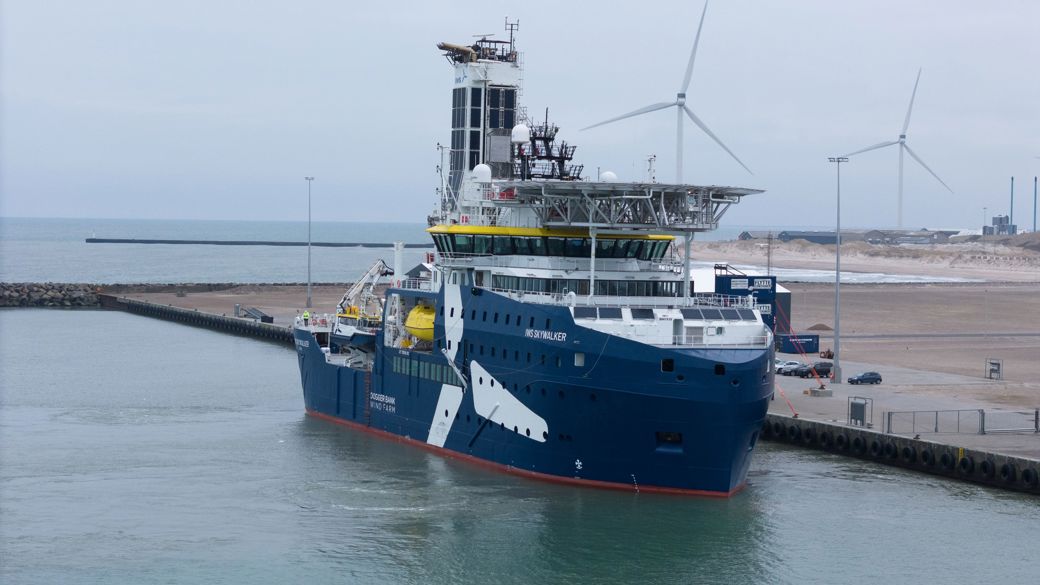Kongsberg Maritime celebrates 50 years since its first ship designs entered service.
From setting the benchmark that set the standard for offshore supply vessels in the 1970s, to advanced anchor handlers that transformed the oil and gas industry, and a growing reference list in fishery and merchant ships, Kongsberg Maritime’s range of ship designs has continued to evolve over the past five decades.

The Far Scotsman, delivered in 1974, was the first UT-Design ship for the emerging North Sea offshore market. This pioneering ship is still in service today as Reliance Star 1.
The early 1970s, at the dawn of the offshore oil and gas industry, saw the very first vessels, designed specifically for the harsh operating conditions of the North Sea.
The ‘UT Design’ range soon became the benchmark design for the industry and have remained at the forefront of the offshore industry, ever since. The UT design range has also developed to include other ship types including oceanographic research, coastal protection and most recently vessels designed specifically for operating in offshore wind farms.
In other markets, covering cargo, passenger and fishing fleets, the company has delivered around 200 ships from its ‘NVC’ family of designs. Over the years, NVC designs have covered a wide range of vessels. These include cargo ships and high-speed Ro-Pax ferries, explorer cruise ships and an extensive range of vessels for the fisheries and aquaculture market.
Lisa Edvardsen Haugan, President Kongsberg Maritime, said: “Over the past 50 years, our design teams have created an extensive portfolio of innovative ships for all market segments. As we reach our fiftieth year, we’re delighted to report that we will also soon be delivering our 1,000th ship design.

IWS Skywalker is the latest Kongsberg Maritime vessel design. It is a state-of-the art windfarm commissioning service operation vessel (CSOV) due to start operations in the North Sea.
“In the same way as the very first UT 704 platform supply vessel ventured out into the North Sea back in 1974 as a pioneer of its time, our latest state-of-the art windfarm service operation vessels (CSOV) - a fleet of six ‘Skywalker Class’ UT5519 DE for Integrated Wind Solutions - will again be pioneering operations in the energy markets offshore”.
"Owners, faced with higher fuel costs, want vessels that use less energy, so there is a shift towards more electrification and battery-hybrid solutions. The use of alternative fuels is also very relevant for how ships are designed, such as methanol and ammonia fuelled ships"

“We are a technology company that delivers a wealth of innovative solutions and technologies, which we incorporate into our ship designs. That combined knowledge across the company, together deep and lasting relationships with ship owners, many of which are based in Norway, gives us a unique capability to offer modern solutions in an efficient way”.
Kongsberg Maritime’s ship design philosophy is centred around three key pillars: safety; operational efficiency and sustainability. Many of the ships designed by the company operate in some of the harshest conditions on the planet, so there is always a laser-sharp focus on safety in all designs. Operational efficiency is another crucial element, with a growing demand for vessels that can operate efficiently for decades.
Lisa Edvardsen Haugan, adds: “The most significant driver impacting how we design ships today, is sustainability. It’s not only regulators that are demanding ships have lower emissions, owners, faced with higher fuel costs, want vessels that use less energy, so there is a shift towards more electrification and battery-hybrid solutions. The use of alternative fuels is also very relevant for how ships are designed, such as methanol and ammonia fuelled ships”.

New PSV and AHTS designs - The latest platform supply and anchor handler designs from Kongsberg Maritime feature innovative technologies and can operate on alternative fuels, including methanol and ammonia
The Kongsberg Maritime ship design team is based in Hjørungavåg and Aalesund on the west coast of Norway, and is supported by a Kongsberg-owned Croatian company, Navis Consult, which provides a range of engineering services in support of the company’s products and ship design projects.
The company has produced a magazine charting the history of its ship design story, including details of some of the significant vessels, key innovations, and the current and future designs. It can be read here.
UT – an offshore pioneer
At the dawn of North Sea offshore oil and gas in the early 1970s, the choice of offshore vessel was limited, with the only options being simple service vessels used in the relatively shallow waters of the Gulf of Mexico. They were soon found to be lacking in capability, particularly enough freeboard, and seakeeping.
The solution to these early challenges came from a small shipyard group on the west coast of Norway. Ulstein Trading (UT), formally set up in 1967 as the sales and ship design company within the Ulstein Group, soon set about designing what would become the vessel of choice for the offshore industry.
They looked at specific requirements for the emerging oil and gas operations and importantly, consulted with Norwegian fishing fleet owners, who had vast experience of working in the North Sea. The result was the ‘UT’ design, and the UT 704 platform supply vessel entered service in 1974. More than 800 UT vessels have been built, while the majority are for offshore operations, the design has evolved for other duties including coastguard, research, and construction.
The origins of the NVC merchant ship portfolio
It began with a Norwegian company called Nordvestconsult, a design house initially working on fishing vessels and a variety of dry cargo vessels. In the late 1990s, the company was acquired by the Ulstein Group, which was already designing and building vessels for the offshore market, with an established reputation. The coming together of the two companies offered a broader range of ship design expertise to the market. The ship technology part of Ulstein Group was then sold to the British company Vickers, and Rolls-Royce in 1999, then in 2019 it became part of Kongsberg Maritime.
ENDS
For more information, please contact:
